Reserve Bank Bulletin – August 1997 Quarterly Report on the Economy and Financial Markets
Introduction
Inflation in Australia has declined over recent quarters, and is now running below 2 per cent, compared with over 3 per cent a year ago. This decline owes something to an appreciation of the Australian dollar during 1996, but is also being assisted by some further decline in rates of growth of labour costs. Inflationary expectations have also declined, as it is increasingly accepted that low inflation will be a permanent feature of the economic scene in Australia. These trends, and the Bank's assessment that inflation is likely to remain quite low for some time ahead, have provided scope for lower interest rates, and the Bank has eased monetary policy twice since the time of the Semi-Annual Statement to Parliament in early May.
The increasing evidence that low inflation is being maintained – which is a feature of the business and economic environment globally – makes for a sound base for economic expansion. Since the beginning of the recovery from recession around the middle of 1991, the economy has experienced six years of uninterrupted growth. Growth began slowing to below-trend rates during 1995, a process which continued in 1996 and, as a result, business conditions in many areas have been lacklustre and employment growth weak. While this slowing has been relatively mild in comparison with other mid-expansion lulls, a corollary of it is that unemployment, having fallen from over 11 per cent to around 8½ per cent, has marked time for about two years now.
Growth is gradually picking up, however, with the rate of expansion in the first half of 1997 ahead of that in the second half of 1996. It is more likely that growth will gradually accelerate further than that it will slow down, particularly once any dampening effects of fiscal consolidation begin to wane. A number of supportive factors are in place. Monetary policy is providing some expansionary impetus: the structure of interest rates for most borrowers is lower now than at the previous low point in 1993, including in ‘real’ terms. The world economic environment continues to be broadly supportive, with steady, low-inflationary growth in the United States economy and a stable policy environment, and continued growth in a number of other trading partners. (Admittedly, growth prospects in some of the east Asian economies may be affected by recent financial instability.) Domestically, while businesses have had to work hard to earn profits, the improving cost structure in many areas makes for a sound investment environment. Business confidence, although not strong, seems to have been improving, particularly expectations about future conditions. As these factors exert their influence over the coming year, further acceleration in growth can be expected to be accompanied by a resumption in employment growth and a further reduction in the rate of unemployment.
The recent slowing of wages growth will also be a welcome help in this regard. On the latest reading, ordinary-time earnings growth has slowed to an annual rate of 3¾ per cent and, allowing for some likely measurement distortions, wage rates at an aggregate level may be increasing more slowly than that. Growth of wages and salaries in leading-edge sectors – enterprise bargains and executive salaries – appear also to have slowed a little, on the most recent data. These developments are, presumably, a response both to the softer labour market conditions of the past year or two and the decline in price inflation. A continuation of these trends would assure containment of labour costs in the period ahead. The outcome of important arbitrated wage claims, particularly the Safety-Net Review, will also be helpful in containing labour costs and supporting employment.
With aggregate wage pressures easing, inflation expectations declining, and ample spare capacity in the economy, the Bank judged that there were no major inflationary risks on the horizon, and that monetary policy could be eased to provide further support for growth. Of the two easings in the past three months, the first was a surprise to financial markets. Within a short period, however, markets came not only to accept it, but equally quickly to anticipate the second reduction. The response of yields across the curve, and of the exchange rate, were more or less as expected.
The present setting of policy also embodies a judgment that even if growth in demand turned out to be a little higher than expected, the economy has scope, in the short term at least, to respond without serious inflation consequences.
The Australian Economy
Economic activity
Indicators continue to point to firmer growth in economic activity during 1997 than was recorded in the previous year, although the extent of the pick-up has been more difficult to judge in the most recent months. In the March quarter of 1997, non-farm GDP increased by 0.8 per cent and total GDP by 0.9 per cent, the strongest quarterly result for a year. Non-farm GDP growth over the year to March, at 2.1 per cent, was below trend, but this mainly reflected weakness in the second half of 1996 (Graph 1).
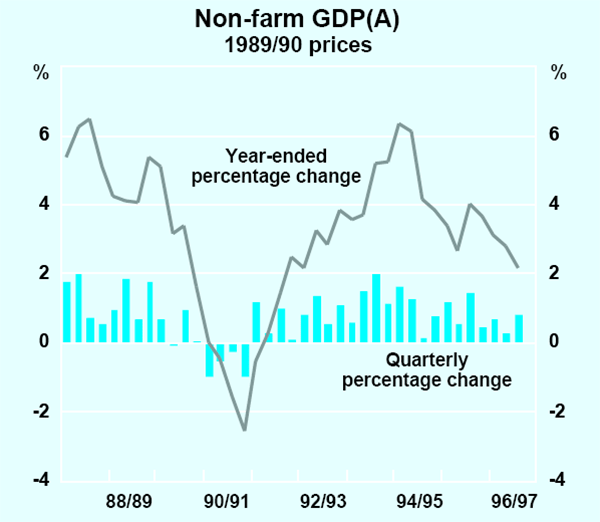
The pick-up reflected strong growth in all the main areas of private spending, including the early stages of the housing upturn, along with continuing strong growth in business investment and faster consumption growth. Private final demand increased by 2.2 per cent in the quarter and has, in fact, been picking up for some time, reaching a growth rate of 4.9 per cent over the year to the March quarter. Exports were also reasonably strong in the March quarter after slower growth in 1996. These areas of strength have been offset to some extent by weaker public demand as well as by a sizeable reduction in stocks (Table 1). This stock run-down should help to set the stage for stronger activity later in the year, although stock levels in the manufacturing industry appear still to be above trend.
| March quarter |
Year to March quarter |
Contribution to GDP Year to March quarter |
|
|---|---|---|---|
| Private demand(a) | 2.2 | 4.9 | 3.7 |
| Public demand(a) | 1.5 | 0.8 | 0.2 |
| Domestic demand | 2.1 | 4.0 | 3.9 |
| Increase in stocks(b) | −1.9 | −1.7 | −1.7 |
| Net exports(b) | 0.6 | −0.3 | −0.3 |
| GDP(E) | 0.8 | 2.0 | |
| GDP(A) | 0.9 | 2.4 | |
| Non-farm | 0.8 | 2.1 | |
| (a) Excluding transfers (b) Contributions to growth in GDP |
|||
Information available for the June quarter suggests a further expansion in demand and output, although not at the same pace. While business investment continues to grow strongly, and the housing sector upswing is moving ahead, growth in private consumption appears to have been weaker from March through to June after a strong start to the year. In the year ahead, the degree of momentum in housing and business construction investment will be important determinants of the economy's growth path. Also important for the achievement of a balanced expansion will be a surer trend in consumer demand, and a resumption of stronger growth in exports to the Asian region. A detailed discussion of the domestic economy follows.
The business sector
Investment
Business investment has now been showing solid growth for a period of around five years, and has been an important engine of growth in the current expansion. The growth has been broadly based for much of that time, encompassing strong growth in the manufacturing, mining and service industries, private-sector infrastructure and non-residential construction developments. More recently, investment growth has begun to be more heavily concentrated in construction rather than plant and equipment. Over the year to the March quarter, real growth in aggregate business investment was 16 per cent, with the plant and equipment component growing by 13 per cent and construction by 25 per cent.
Forward indicators of investment plans suggest that this compositional shift is likely to continue, with an easing in the pace of aggregate investment growth while the construction component is expected to remain strong. The latest capital expenditure survey, conducted in April and May, shows construction expenditure in 1997/98 expected to be 25 per cent higher than the corresponding set of estimates taken a year earlier. The figure for the plant and equipment component is a fall in expected investment of 8 per cent over the same period, which would leave total investment broadly flat (Graph 2). While these expectations can be subject to substantial revision, they imply a somewhat weaker outlook than presented in the previous survey taken in January/February. Nonetheless, a strong outlook for construction activity remains a consistent feature of the survey results. In addition, recent growth in imports of investment goods gives a somewhat firmer impression of equipment investment than the capital expenditure survey expectations.
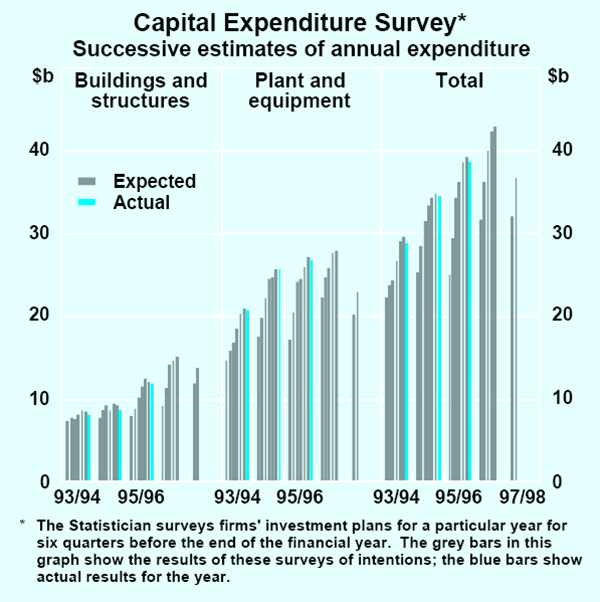
Other forward indicators of construction activity confirm the outlook for strong growth in that area (Graph 3). Non-residential building commencements, although volatile, continue to trend upward, and there have been rapid rises during the past year in both work done and work outstanding. Unlike the pattern in the construction boom of the late 1980s, the stock of work outstanding is broadly spread across offices, shops, hotels and other business premises. Olympic-related work should provide further support to demand for some time, and there are some other large projects committed which are yet to show up in the commencements figures. Declining office vacancy rates in several major cities suggest a strengthening underlying demand for office premises, although vacancy rates remain at relatively high levels in most cities.
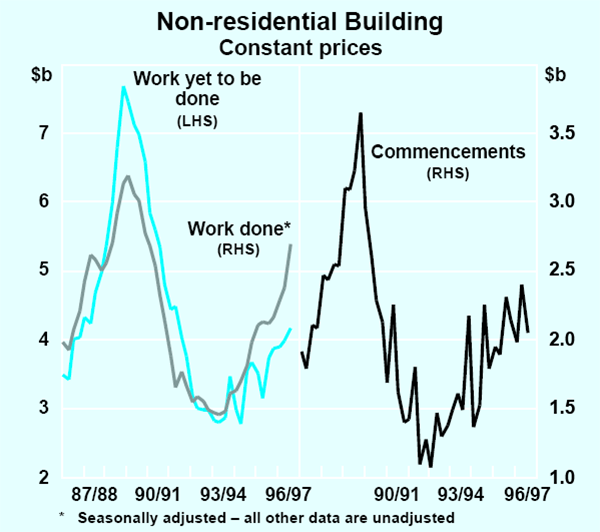
The outlook for engineering construction activity is also for solid growth. Commencements still seem to be trending upward despite recent volatility, and the stock of work yet to be done remains at a very high level. Much of this strength is related to the mining sector, particularly in base-metals projects, along with private-sector infrastructure projects such as CityLink in Victoria. Looking further ahead, the Access investment monitor suggests that there remains a high value of mining and resource-related projects which are under consideration by companies. This should help underpin investment growth for some time.
The weaker expectation for equipment investment over the next year is concentrated mainly in the manufacturing sector, where expected investment according to the Capital Expenditure Survey is 16 per cent below the level of a year ago. The weaker manufacturing outlook reflects several factors, including the cumulative impact of very low rates of increase in selling prices, combined with continuing high wage settlements in many parts of the sector, which have contributed to declining profitability and relatively weak business confidence. Also important is that capacity utilisation is relatively low, following several years of strong investment growth and a period of weaker growth in sales. A high stock-to-sales ratio relative to the longer-run downward trend also suggests that manufacturers may still have a significant stock overhang (Graph 4).
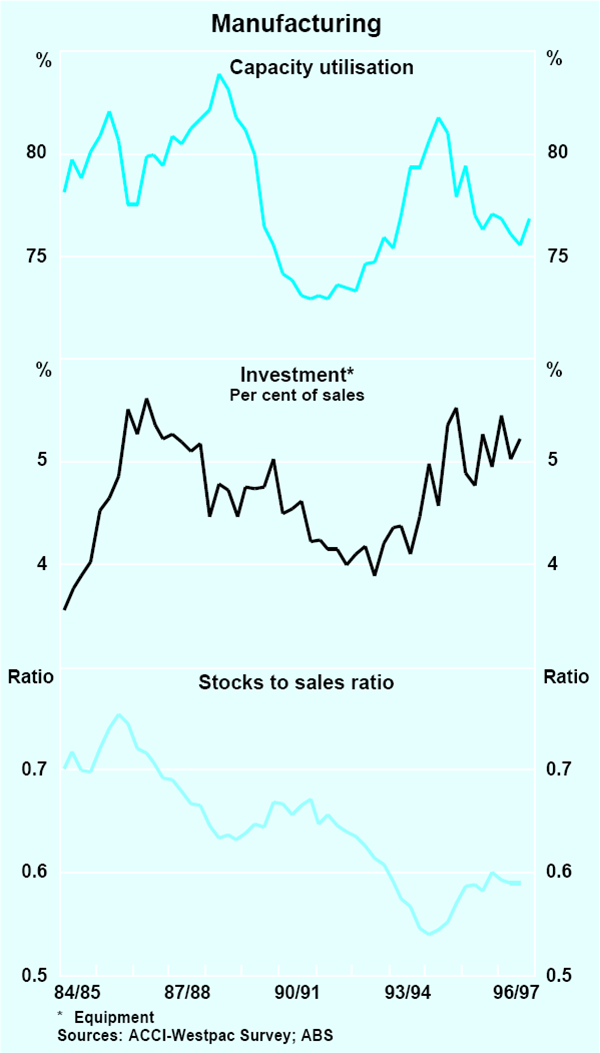
Notwithstanding these factors, some surveys suggest that confidence in the manufacturing sector may have begun to pick up from its recent low levels. Factors that may contribute to a more positive outlook include the continuing effects of interest-rate reductions and the expected strong growth in housing and construction which should contribute to stronger sales growth in the period ahead.
Profits
At an economy-wide level, business confidence and the climate for investment seem to be undergoing some modest improvement (Graph 5), supported by firming expectations of sales and profits. Aggregate business profitability, although declining moderately over the past two years, remains at reasonably good levels by historical standards. Gross operating surplus of the corporate sector fell slightly in the March quarter to a level equivalent to 14.8 per cent of GDP, only just below its decade average of 14.9 per cent. Profits after interest showed little change in the March quarter, but can be expected to benefit over time from the effects of interest rate reductions that have taken place over the past year, as these flow through into profit results. Profits of unincorporated businesses have been showing modest improvement over the past year.
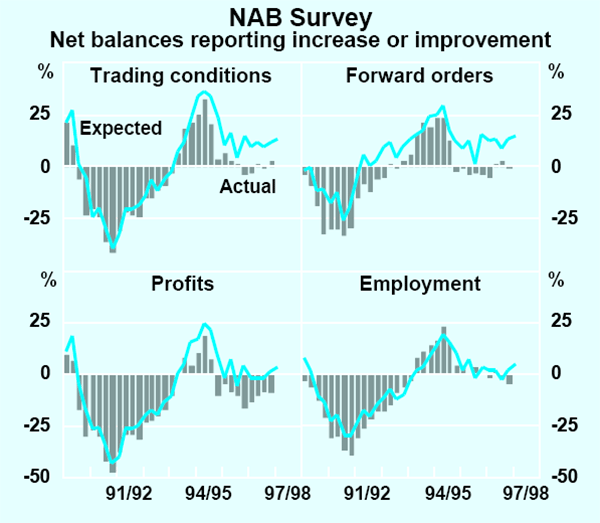
As already noted, profits in manufacturing industry have been weaker than those for the economy as a whole, declining by almost 10 per cent over the past two years (Table 2). Profits in wholesale and retail trade have also performed considerably below average in the recent period, while profits in mining, transport and services have grown strongly. These trends are broadly reflected in the industry mix of investment intentions, which are strongest in the finance, property and other service industries, predominantly on the building side, and relatively weak in manufacturing. Mining investment remains at a high level and has grown by around 30 per cent since late 1995.
| Industry |
Annualised two-year growth (%) |
|---|---|
| Mining | 13.0 |
| Manufacturing | −4.6 |
| Construction | 8.1 |
| Wholesale and retail trade | −6.9 |
| Services | 23.7 |
| TOTAL | 3.5 |
| Note: Profits data for services sector are inflated by the inclusion of recently privatised companies in the electricity and transport sectors. | |
Business finance
Recent trends in business funding suggest a slowing in the pace of balance-sheet expansion. Total business funding from domestic sources, comprising retained profits, equity raisings by listed companies and business borrowing from financial intermediaries, fell from 15¼ per cent of GDP in the December quarter to 14½ per cent in March, despite a small pick-up in retained earnings (Graph 6). The flow of new intermediated debt to the corporate sector has eased back from a run of strong quarterly readings, and is now around 2¾ per cent of GDP, very close to its decade average. Moderate business credit growth points to a continuation of this trend in the June quarter. The volume of new equity raisings eased in the March quarter following a strong December quarter figure. The overall level of corporate funding appears consistent with expectations of more modest investment growth in the near term.
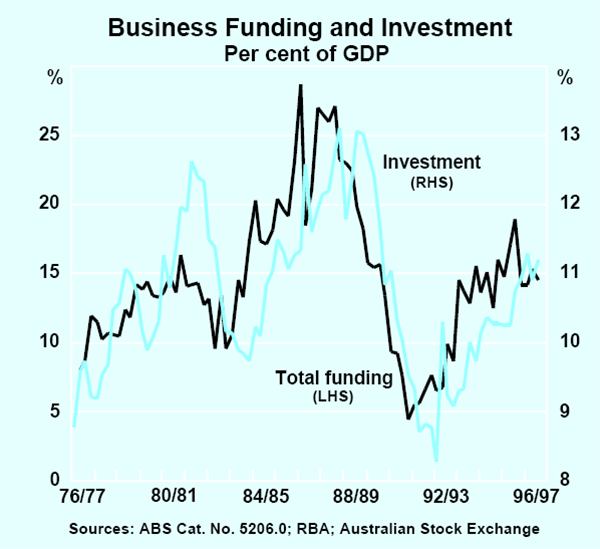
The household sector
Dwelling investment
The upward trend in the forward indicators of housing activity, evident since at least the start of this year, has been continuing. Notwithstanding a decline in the past two months, the number of private building approvals in the June quarter reached a level around 15 per cent higher than the average in the second half of 1996, and this is beginning to flow through into rises in commencements (Graph 7). Housing finance indicators suggest a strong upward trend. In the June quarter, loan approvals for existing dwellings were 35 per cent higher than in the June quarter last year and loan approvals for new construction were up by almost 30 per cent. The housing expansion is being supported by historically high levels of affordability, but a continuing supply overhang in a number of areas suggests that the pace of expansion is likely to remain below the average of previous cycles.
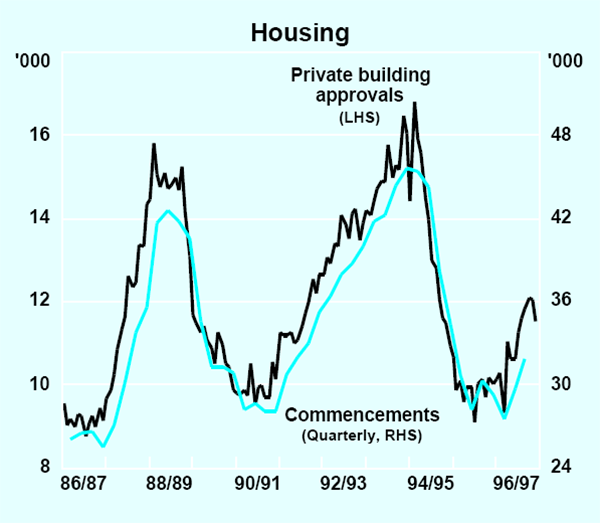
A feature of the current housing expansion is that it has been unevenly distributed both geographically and in its composition between houses and medium-density dwellings. The medium-density sector picked up quite sharply in the eastern States in early 1996, well ahead of the more general upturn in housing activity (Graph 8). Strong investor demand in this area reflected rising dwelling rents, as well as an apparent shift in preferences towards inner city living and relatively low and declining vacancy rates for private rental accommodation in Sydney and Melbourne. Between the March quarters of 1996 and 1997, medium-density building approvals in the eastern States increased by 65 per cent. Elsewhere in Australia they were still declining over that period.
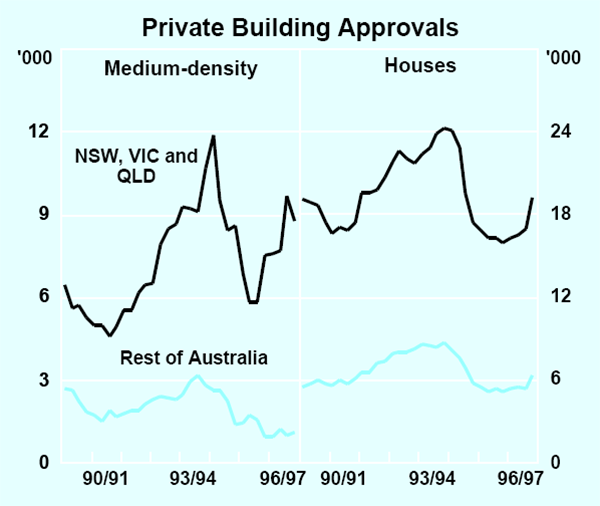
More recently the housing upturn has shown signs of spreading more widely geographically and has shifted in composition towards private houses. The number and value of approvals to build private houses has grown quite rapidly through the first half of 1997, even abstracting from the contribution of the Olympics project, although the May and June figures were weaker. Medium-density approvals, in contrast, have plateaued around the levels reached in the December quarter. Related to this, housing loan approvals for investors have also been falling in recent months. Signs that medium-density housing activity may be in for a period of slower growth include recent falls in rents in some areas and a levelling out in vacancy rates; in Sydney, where the increase in medium-density supply has been strongest, vacancy rates have, on some measures, actually started to rise.
At the same time as this compositional shift is occurring, overall demand for housing, and the shift from rental to home ownership, continue to be underpinned by very high levels of home-loan affordability. Mortgage interest rates following the latest easing in cash rates have come down to levels of around 6½–6¾ per cent, the lowest since the early 1970s. With repayment burdens associated with house purchases now at historically low levels, there is no doubt that this is providing significant stimulus to the housing market.
Strong demand for housing has also been putting upward pressure on house prices in some cities, particularly in Sydney and Melbourne (Graph 9). According to the measure published by the REIA, average house prices in Sydney in the March quarter were 12 per cent higher than a year ago, while the rise in Melbourne over the same period was 10 per cent. More recent monthly data from the same source are highly volatile but point to further increases. These measures of house prices can, however, be affected by increased activity at the upper end of the market, where price increases to date seem to have been concentrated. There are still signs of surplus supply in the outer suburbs of both cities. The ABS measure of house prices, which excludes the top and bottom 10 per cent of the market, shows more moderate price increases in Sydney and Melbourne, although some tendency for these increases to gather pace is still evident. In the other capital cities, house prices have been more subdued, although the REIA data are suggesting some pick-up in Adelaide, Brisbane and Perth since mid 1996.
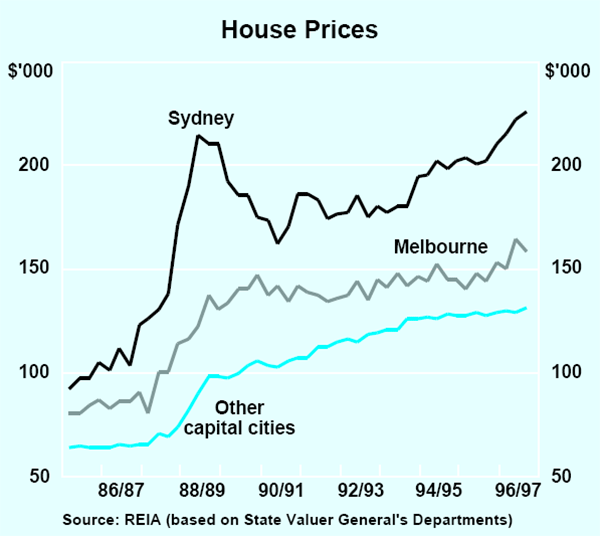
Some degree of upward pressure on house prices can be considered a normal part of the transmission process whereby an increase in demand flows through into increased building activity. Higher demand tends to be focused at least partly on the existing stock of houses and leads to a bidding up of prices, particularly in areas where supply is relatively short; over time, the stronger demand can be met by increased building activity. At this stage, the rises in house prices have been reasonably localised and do not seem to indicate any general increase in inflationary expectations, although this will be an area to be watched as the housing upturn continues.
Consumption
Household consumption spending picked up strongly in the early part of 1997, but seems to have lost momentum in more recent months. Retail trade grew by just over 2 per cent in real terms in the March quarter after being flat for much of the previous year; it then showed a small fall in the June quarter (Graph 10). Interpretation of this pattern is made difficult by the volatility of the underlying monthly numbers, including some unusually large fluctuations around Christmas and Easter. These have probably had the net effect of drawing spending into the March quarter from before and after that period, and therefore exaggerating both the pick-up in the March quarter and the subsequent weakness. The June monthly figure was also affected by the delay of mid-year sales by some major retailers, which should help boost the July figures. A more realistic assessment may therefore be that consumption was growing in trend terms throughout the first half of the year, with the pace stronger in the March than in the June quarter. A continuing uptrend is evident in motor vehicle registrations, which rose by 0.7 per cent in the June quarter following growth of 8.9 per cent in the March quarter. The higher level of registrations partly reflects the effects of falls in motor vehicle prices occurring over the past year as a result of earlier exchange-rate appreciation.
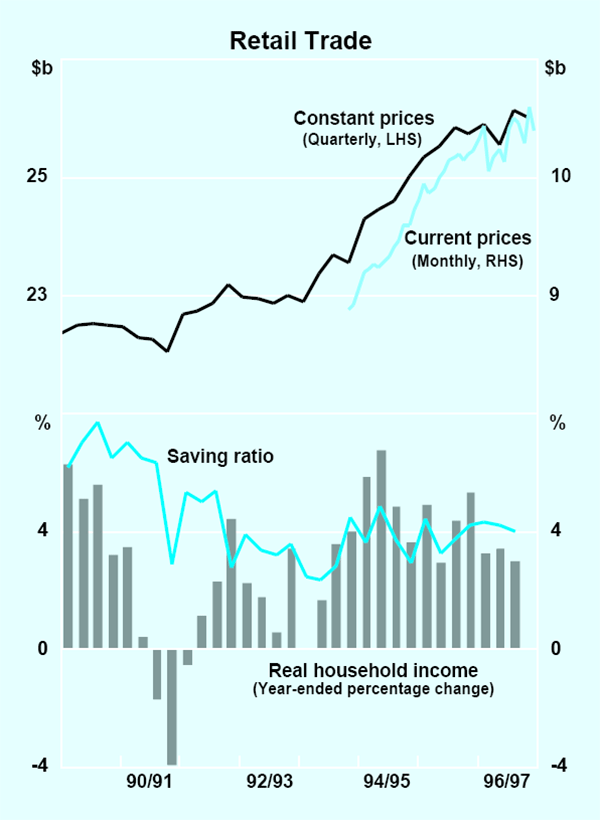
The trend in consumer spending over the past two years has been influenced by a gradual decline in the rate of growth of household incomes which, in turn, reflected weaker employment growth and a moderation in wage outcomes. This has been combined with an apparent desire on the part of consumers to at least maintain their levels of saving after saving rates had fallen to historically low levels. Spending was boosted in the March quarter by a small decline in saving, but the indications are that consumers remain fairly cautious and are quite pessimistic about labour-market prospects. A more sustained pick-up in spending will require stronger growth in household incomes, which in turn will be dependent on a resumption of employment growth.
Household financial positions
While housing saving rates have shown only small movements recently, household assets and liabilities have continued to expand. On the asset side, this has mainly reflected accumulation of earnings in managed investment funds while, on the liabilities side, it reflects the growth of housing-related borrowing. Financial assets of the household sector grew by 11.2 per cent over the year to the March quarter, with growth concentrated in superannuation funds and other managed investments (Graph 11). These investments have continued to earn high average rates of return. Holdings of more traditional deposit products grew more slowly, by 7.1 per cent over the same period.

Household liabilities have also expanded faster than income, reaching a level of 94 per cent of aggregate household income in the March quarter. This ratio continues to trend upward, but remains moderate by international standards. Housing credit growth has picked up recently, reaching an annual rate of 12.1 per cent over the six months to June, compared with 9.6 per cent over the previous six months. Other personal credit growth has also picked up slightly in recent months. Notwithstanding the increases in debt ratios, household interest payments have been declining as a proportion of income, reflecting interest rate reductions over the past year.
The labour market
Performance of the labour market so far in 1997 has been lacklustre, with little net change in total employment since the start of the year, notwithstanding the stronger figure in July (Graph 12). Part-time employment has continued to trend upwards, but this has been offset by declining full-time employment, which weakened further in the first half of 1997 before a rebound in July. The unemployment rate has remained within a range either side of 8½ per cent for the past two years, while labour force participation rates have been declining.
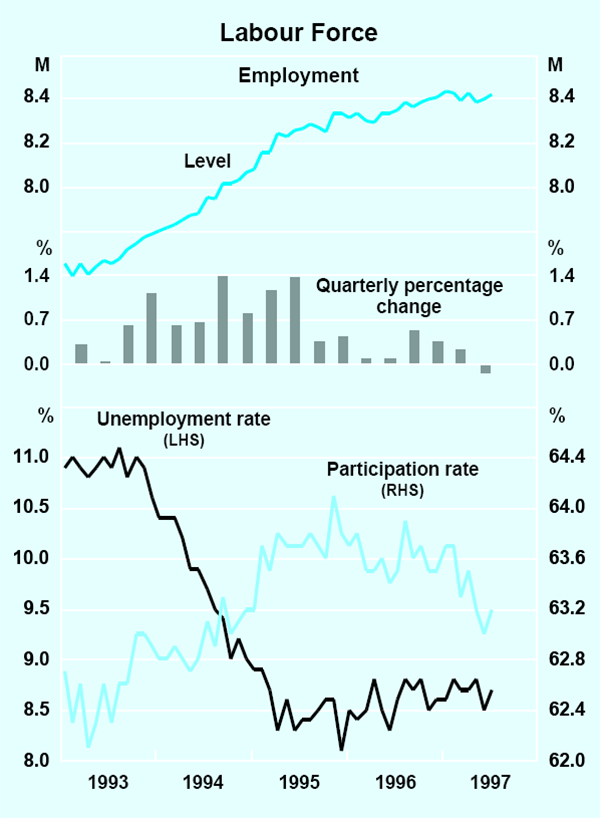
The levelling out of total employment in the first half of 1997 follows a period of around 18 months when employment grew at an annual rate of about 1 per cent. This change in trend in 1997 seems to have reflected, at least in part, the slowing of overall economic growth in the preceding half year. Growth in non-farm product in the second half of 1996 slowed to an annual rate of 2 per cent – not much more than average productivity growth has been in the current cycle, and insufficient to generate sustained growth in employment. In that sense, the slowing of employment growth should be viewed as having a significant cyclical component which can be expected to respond as the general pace of activity picks up.
Another important factor in the demand for labour, however, is the growth of labour costs. For much of the recent period, ordinary-time earnings and other measures of wage rates have been growing at rates of around 4 per cent or more, while output prices have been rising much more slowly: for example, the fixed-weight GDP deflator in the year to the March quarter rose by only 1.3 per cent, while manufacturers' output prices have been rising at rates of around 1 per cent. The combination of high wage rises and flat selling prices is likely to have contributed to pressure on employers to contain costs through employment reductions and the substitution of capital for labour. Consistent with this view, business surveys have for some time been suggesting a strong preference to expand output through productivity growth rather than employment growth. Against this background, the recent easing of wage pressures in response to weaker labour market conditions is a welcome development which, if sustained, should help increase the willingness of businesses to increase employment as the economy picks up.
There have been some sharp differences in employment trends across industries over the past year. Growth has been weakest in some cyclically sensitive industries and in industries affected by fiscal consolidation or privatisations, such as public administration, education and utilities. Some of these effects probably still have a way to run, although prospects for a cyclical pick-up in employment in the construction industry appear to be good. Employment growth has remained relatively firm in a number of private-sector service industries, particularly business services and the hospitality industry.
More forward-looking indicators of labour demand continue to point to the prospect of some improvement. The number of private-sector job vacancies increased by 6 per cent over the three months to May, continuing the upward trend evident for the past two years, and bringing the level of vacancies not far short of the peak reached in 1994 (Graph 13). The ANZ measure of job vacancies, although showing an uneven pattern in recent months, has been on a rising trend, to be up by 6 per cent since the beginning of the year. Business surveys suggest that near-term hiring intentions have picked up recently, although they remain at only moderate levels.
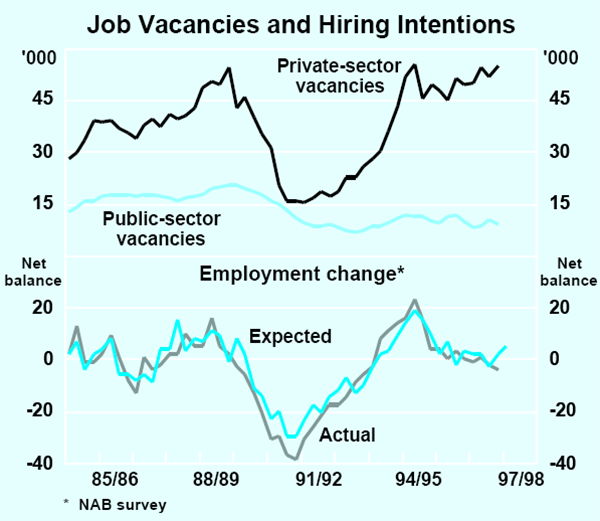
The external sector
Imports and exports both grew strongly in the June quarter, although the export growth was driven largely by two special factors, the sale of an ANZAC frigate to New Zealand and the sale of gold by the Reserve Bank. Both of these items represent sales from existing stocks and they do not therefore contribute to growth of production in the June quarter. Allowing for that, net exports are expected to detract from growth in the June quarter, while the balance on goods and services, excluding the special factors, is expected to move into deficit after being in surplus for most of 1996.
The statistical treatment of the Reserve Bank gold sales involves reclassification of the gold from a financial asset to a produced asset, and then the sale of this commodity to a non-resident. The sale is recorded as an export in the balance of payments when it changes ownership; this took place mostly in the June quarter but some will also occur in the September quarter. The reclassification of the gold as a produced asset means that it is counted as part of public authorities' stocks at the time it was sold. There is therefore a reduction in stocks equal to the increase in exports, and no net effect on GDP.
Growth in the quantity of imports shows fairly clear signs of having picked up through 1997, reflecting healthy levels of domestic demand and the rise in the exchange rate during 1996. The quantity of imports of goods and services is estimated to have risen by around 5 per cent in the June quarter, following little growth in the March quarter. While growth has been reasonably broadly based, it has been particularly strong for consumption and capital goods imports. The pick-up in consumption goods imports has been spread across most durable components and is consistent with higher anticipated levels of consumer demand and some degree of stock rebuilding on the part of wholesalers and retailers. Strength in capital goods imports has now been evident for two quarters, and may suggest a firmer trend for plant and equipment investment than is implied in the recent capital expenditure survey. In the June quarter, growth was particularly strong in imports of telecommunications equipment, which may be related to the next phase of deregulation of the telecommunications industry.
The quantity of exports of goods and services is estimated to have increased by over 10 per cent in the June quarter, driven predominantly by the export of the ANZAC frigate and the Reserve Bank's gold sales. Excluding these special factors, export growth was about 2 per cent, with weakness in rural and resource exports offset by reasonable strength in exports of manufactures and services in the quarter. But, despite a reasonably strong March quarter, export growth, in an underlying sense, has been sluggish since early 1996.
A somewhat higher exchange rate is one factor likely to have made some contribution to this weakness in export growth. From the beginning of 1996 to the present, the exchange rate has averaged 58 in trade-weighted terms, which is close to its decade average but around 10 per cent higher than the average level over the previous four years. Also important has been the slowdown in growth of east Asian trade (Graph 14). Slowing in growth of output and trade volumes in the east Asian region has occurred for a variety of reasons, including a need to combat problems of overheating in some economies and a slump in the world electronics market. This appears to have had an impact on sales of Australian exports in the region, independently of the effect of exchange-rate movements; growth in exports of resource products, which do not tend to be very sensitive to the exchange rate, has slowed significantly since late 1995.
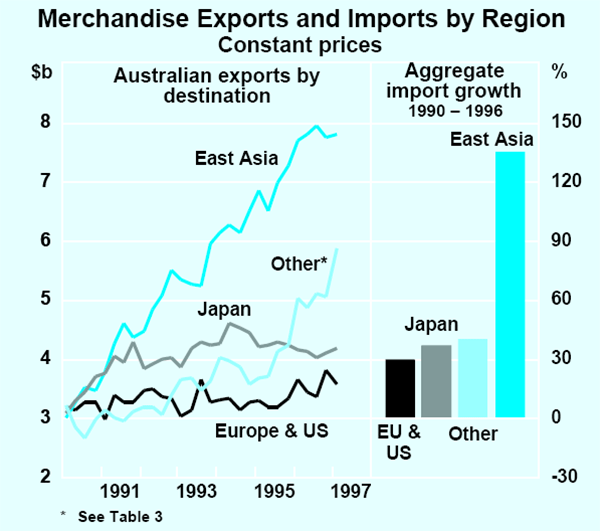
An expansion of exports to a range of smaller non-traditional markets (details are shown in Table 3) as well as the US, has partially offset this weakness; around 40 per cent of the growth in exports that has occurred over the past two years can be attributed to growth in exports to these markets. To some extent, this strong growth is due to factors (such as the growth in cereal exports associated with the record 1996/97 wheat harvest) that will probably not be repeated. However, structural changes, including trade liberalisation, could further raise the importance of these markets in the future, although perhaps not at the same rate as in the past couple of years.
| Country | Export share March 1997 (per cent of total) |
Share of merchandise export growth 2 years to March 1997 (per cent) |
Major commodities |
|---|---|---|---|
| Bangladesh | 0.4 | 2.1 | wheat |
| Egypt | 1.0 | 6.2 | wheat, live animals |
| India | 2.6 | 8.9 | coal, wool |
| PNG | 1.5 | 2.6 | crude oil |
| Iran | 1.9 | 10.0 | wheat |
| Saudi Arabia | 0.6 | 1.9 | wheat |
| South Africa | 1.2 | 3.8 | meat, aluminium |
| United Arab Emirates | 1.0 | 3.5 | live animals |
| Total | 10.2 | 39.0 |
Financial intermediation
Total credit provided to the private sector by financial intermediaries rose by 9.8 per cent in the six months to June. This represents a small pick-up from the pace around the beginning of the year, but overall credit is still growing more slowly than in the first half of 1996. Within the total, business credit appears to have slowed a little in recent months, while housing credit has clearly picked up to be now growing at rates of around 12 per cent (Table 4).
| Three-month annualised rate | Year-ended percentage change | |||
|---|---|---|---|---|
| Mar 1997 | June 1997 | June 1996 | June 1997 | |
| Currency | 4.6 | 11.9 | 3.1 | 5.1 |
| Broad money | 8.5 | 13.3 | 10.3 | 10.7 |
| Total credit | 8.6 | 11.0 | 12.5 | 9.9 |
| – Business | 6.1 | 10.6 | 13.6 | 9.1 |
| – Housing | 11.5 | 12.7 | 11.6 | 10.8 |
| – Personal | 9.9 | 7.4 | 10.7 | 10.1 |
After some years on a downward trend, growth in currency has increased strongly in 1997, to an annualised growth rate of 8.2 per cent in the six months to June, compared with just over 2 per cent in the previous six months. In part, this may reflect declines in the opportunity cost of holding currency: as inflation and nominal interest rates fall, some switching from transactions-type accounts into cash holdings is to be expected. Increases in bank fees on deposits may also have encouraged higher currency holdings by households in order to economise on banking transactions. Any switching behaviour would not show up in broad money, which includes both currency and deposits; both broad money and M3 have been growing at average annual rates of 9–10 per cent for some time. They slowed marginally in the latter part of 1996 and have been growing slightly more quickly so far in 1997.
Inflation Trends and Prospects
Recent developments in inflation
Inflation declined further in the June quarter, dropping below 2 per cent in underlying terms. Underlying consumer prices increased by 0.3 per cent in the quarter, and by 1.7 per cent over the year, down from an annual rate of 2.1 per cent in March and well below the recent peak of 3.3 per cent in the March quarter 1996 (Graph 15). Other measures of trend inflation, such as the trimmed mean and median price increases, show a similar profile over time, and currently put inflation at close to 2 per cent.
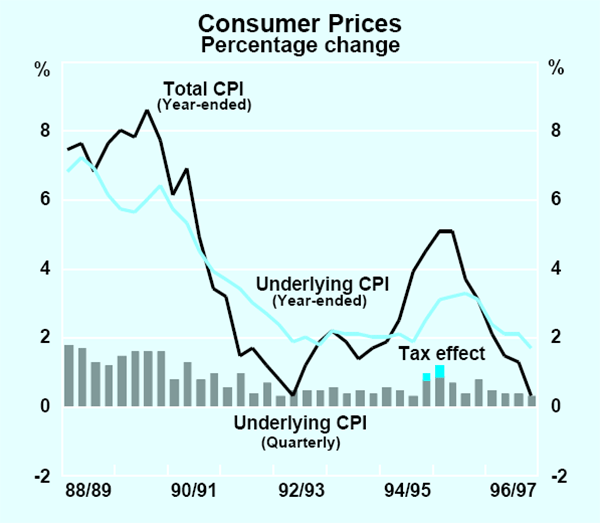
The rate of increase in the Consumer Price Index (CPI) has fallen much more sharply than measures of underlying inflation, reflecting the impact of mortgage interest rate reductions. The CPI fell by 0.2 per cent in the quarter, bringing the year-ended increase to 0.3 per cent, down from 1.3 per cent in the March quarter. The falls in mortgage interest rates announced since February detracted 0.5 of a percentage point from the quarterly CPI inflation rate, and a further negative contribution will follow from the most recent interest rate cut, thus continuing to keep annual CPI increases below the underlying inflation rate for some time.
Other measures of prices have been more subdued than the underlying CPI. Prices of domestically produced manufactured goods increased by only 1.1 per cent over the year to May and house building materials prices by 1.4 per cent over the year to June. This continues a period of very low rates of increase in these prices over the past couple of years, although they have picked up a little in recent months. Input prices for manufactures, both domestically produced and imported, have over the past year been falling. The fixed-weight deflators for final consumption and GDP from the national accounts rose by 1.6 per cent and 1.3 per cent over the year to the March quarter.
Appreciation of the exchange rate over much of the past two years has made a significant contribution to inflation reduction. One measure of this is that prices of predominantly imported goods in the CPI fell by 1.7 per cent over the past year (Graph 16). The exchange rate has declined in recent months, after having briefly been above 61 in trade-weighted terms in March and again early in May 1997. These high levels were not sustained for long enough, however, to have had a significant effect on import prices (Graph 17). The TWI average value over both the March and June quarters was around 59, only slightly above its level of 58¼ at the end of July. If the exchange rate remains at current levels, it would imply relative stability in prices for imported consumer goods, or even some further small declines over the next few quarters, as a result of the continuing (although diminishing) response to earlier exchange rate appreciation.
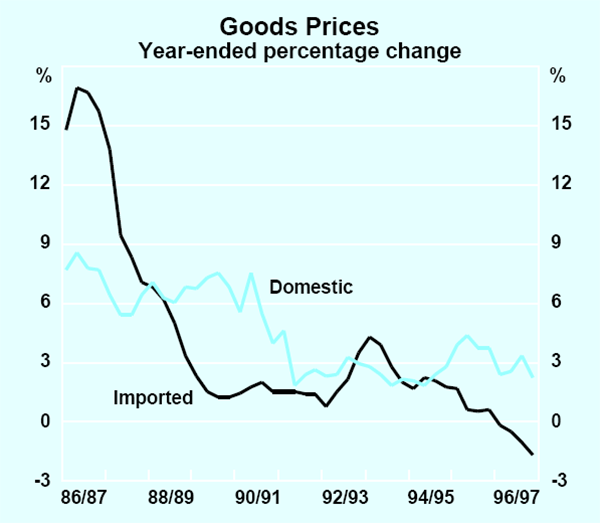

Notwithstanding the important contribution of the exchange rate to recent trends, domestically sourced inflation also appears to be in check. Prices of non-imported goods increased by just 0.1 per cent in the June quarter and by 2.2 per cent over the year, marking a clear deceleration from the position of a year earlier. Services prices (excluding interest charges) have been rising somewhat faster than domestic goods prices, but these increases have nonetheless been diminishing. The prices of private-sector services increased by 0.5 per cent in the June quarter, and by 3.2 per cent over the year. The annual figure is higher than in the March quarter, but well down on the rates recorded a year ago, a trend consistent with the easing in private-sector wages growth over the same period.
Labour costs
Wage pressures at an aggregate level have eased in recent months, probably reflecting a period of weaker labour market conditions as well as declines in inflation expectations. The increase in average weekly ordinary-time earnings (AWOTE) slowed, on preliminary estimates, to 3.7 per cent over the year to May, down from a rate of 4.3 per cent in February (Graph 18); the quarterly increase was just 0.5 per cent. While these data are prone to revision, there appears to be a break from a succession of quarterly increases of around 1 per cent.
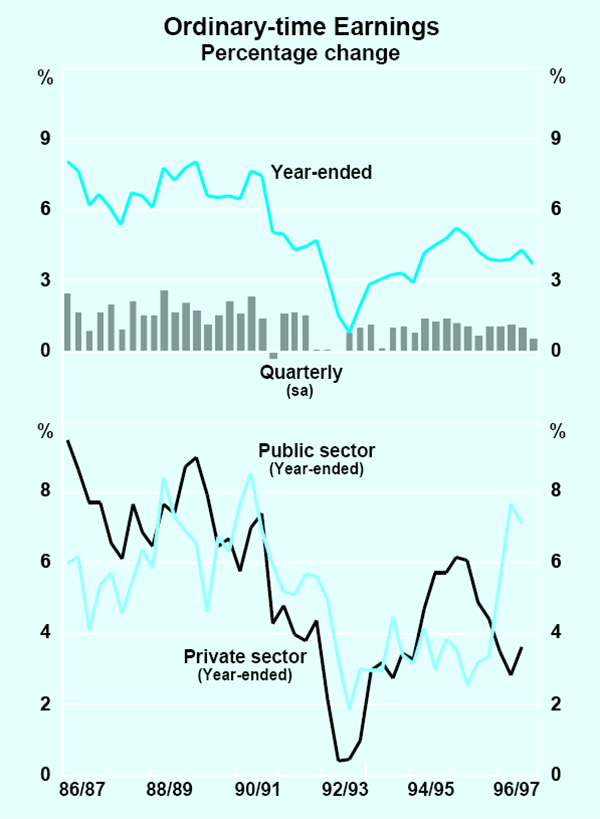
While AWOTE seems conceptually the best of the available published indicators of short-term wage developments, it contains some potential measurement errors that need to be taken into account in assessing its implications for inflation. The most important of these at present concerns the measurement of public-sector wages. For some time, the public-sector component of AWOTE (and other measures of weekly earnings) has been recorded as growing at unrealistically high levels – more than 7 per cent over the year to February. This contrasts with the fairly extensive information available on enterprise agreements in the public sector – which cover the bulk of the public-sector workforce. Those data suggest earnings growth of around 4½ per cent. This comparison suggests that total AWOTE growth has been overstated, assuming that there is no offsetting measurement error in the private-sector component of AWOTE. Another possible source of error, specific to the AWOTE measure, is a trend increase in standard ordinary-time hours, which would tend to make the increase in weekly ordinary-time earnings a slight overstatement of the trend in hourly wage rates. This combination of factors suggests that hourly wage rates may be growing more slowly than the 3.7 per cent officially recorded over the most recent year.
Broader measures of wage growth also point to lower rates of increase recently (Table 5). Total weekly earnings of adults working full time grew by 3.1 per cent over the latest year, and average weekly earnings of all employees increased by 2.5 per cent. These measures are also subject to error. For example, average weekly earnings are influenced by a trend increase in the share of employment accounted for by part-time workers, who have lower weekly earnings; this would tend to lead to an understatement of the increase in hourly wage rates. Nonetheless, all of these earnings measures are showing significantly lower rates of increase than were evident a year ago.
| Feb to May | Year to May | Year to Feb | |
|---|---|---|---|
| Full-time adults | |||
| – Ordinary-time earnings (AWOTE) | 0.5 | 3.7 | 4.3 |
| – Total earnings | 0.6 | 3.1 | 3.7 |
| All employees | |||
| – Total earnings (AWE) | 0.1 | 2.5 | 3.4 |
There are also signs of a slight decline in rates of increase in executive earnings and in wage increases negotiated under enterprise agreements. According to the Cullen Egan Dell survey, executive salaries increased by 5.8 per cent over the year to June, down from a rate of 6.3 per cent a year ago, although still well above community average income growth. There are no new official data on enterprise-bargaining outcomes beyond the March quarter, when new private-sector agreements yielded average wage increases of 4.8 per cent; this represented a modest slowing, from an estimated peak of 5.3 per cent in the previous year (Graph 19). Anecdotal reports of recent claims and settlements suggest that while many enterprise agreements are continuing to yield increases of around 5 per cent, significantly smaller increases may be becoming more common.
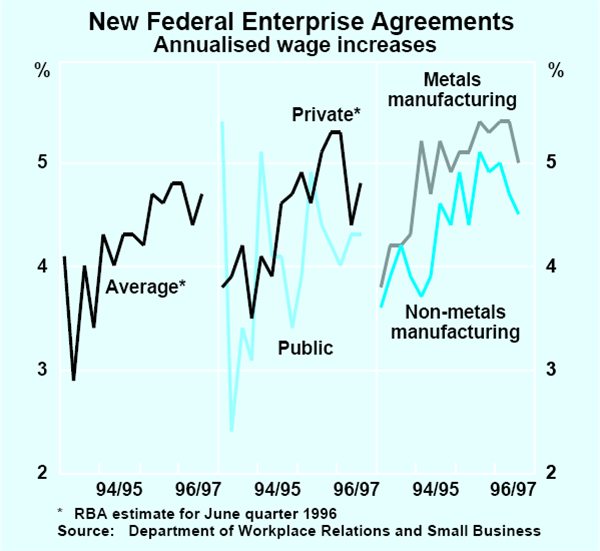
Award wages have continued to grow relatively slowly, rising by 1½ per cent over the year to the June quarter, much the same pace as in the past few years. The $10 safety-net increase approved in the national wage case in April will most likely raise that rate of increase slightly to just under 2 per cent in the period ahead. Based on past patterns of award adjustment, the decision will have its main impact on awards in the September and December quarters, but the overall impact on trends in aggregate earnings is small. A claim for a further across-the-board ‘safety-net’ increase is expected to be heard early next year.
The Workplace Relations Act, which came into force this year, facilitates a new stream of individual contract-making through Australian Workplace Agreements. This facility has been available since March. The Employment Advocate has reported that, by end July, contracts had been approved at 46 firms covering 949 employees, with contracts at a further 90 firms waiting for approval.
Inflation expectations
Measures of inflation expectations have undergone a further significant downward shift over the past few quarters. The shift has occurred across the community, including consumers, businesses and financial market participants. However, surveys suggest that business and consumer expectations remain higher than the Bank's inflation target.
Consumer inflation expectations, as recorded by the Melbourne Institute Survey, moved down sharply in the second half of 1996 and have maintained that low level, or even fallen further, in subsequent months (Graph 20). According to the survey, median expectations of inflation in July for the period a year ahead were 3.3 per cent, close to the lowest figure since the survey began in 1973. The average result for this survey in the past nine months was 3.5 per cent, a clear step down after it had fluctuated around a reasonably stable average of 4.3 per cent over the previous five years.
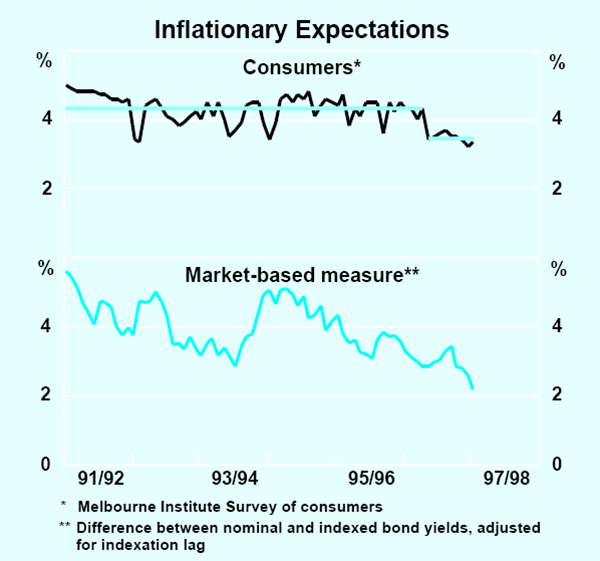
Near-term expectations of business selling prices have remained subdued over the past year and have tended to weaken further on the most recent readings (Graph 21). According to the NAB survey, the average expected selling price increase for retailers for the September quarter is 0.3 per cent. Both the ACM and ACCI-Westpac surveys of the manufacturing sector report declines in the net balance of respondents expecting to increase selling prices in the September quarter. Longer-term business inflation expectations, as recorded in the NAB survey, have been broadly steady this year after declining sharply in 1996. The proportion of business respondents who expect inflation to average more than 4 per cent over the rest of the decade declined slightly to 11 per cent in the June quarter, and has remained well below the roughly one-third of respondents in that category in early 1996. However, the most common expectation in businesses continues to be in the 3 to 4 per cent range.
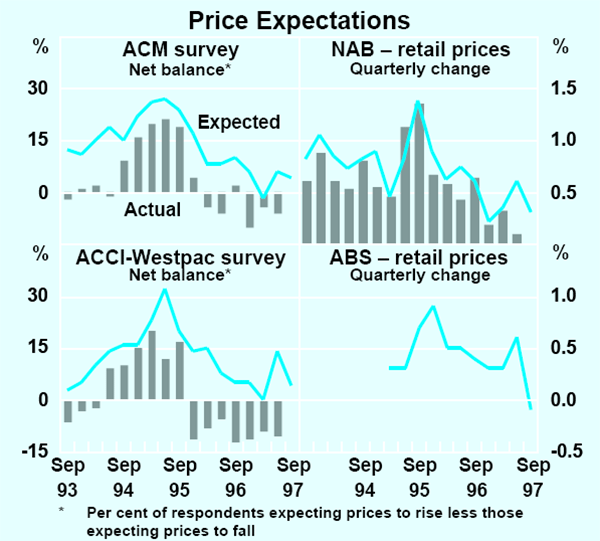
Inflation expectations of participants in financial markets have also been declining. A survey of financial market economists conducted by the Bank in July shows that their expectations of inflation out to mid 1998 have been revised downward in the wake of the latest wage and price data. The median forecast for underlying inflation in the year to June 1998 was revised to 2.2 per cent, from 2.6 per cent in the previous survey; the CPI increase expected over the same period is 1.8 per cent. Respondents to this survey expect some pick-up in underlying inflation over the subsequent year, to 2.9 per cent. An indicator of longer-term market expectations, the indexed bond differential, also records a significant decline in inflation expectations over recent months. This indicator, by end July, was implying a 10-year inflation expectation of 2¼ per cent, in the lower half of the inflation target and well down from figures of around 3–3½ per cent that had prevailed a year earlier.
The inflation outlook
Developments over recent months have increased the likelihood that inflation will remain at low rates for some time. The June quarter results for prices confirm a fall of inflation below 2 per cent in underlying terms, and even some slight pick-up in quarterly rates of increase would leave underlying inflation no higher than 2 per cent in the short term.
The recent fall in inflation has been helped by a firm exchange rate, and this factor is likely to wane over the coming year if the TWI remains at current levels (although the Bank does not expect that current levels of the exchange rate will add significantly to import prices). Over this period, then, the trend in domestic factors bearing on inflation will become more important.
Recent information about those factors generally points to a somewhat slower trend in domestic inflation than seemed likely six months ago. Most important in this has been the apparent easing in growth of labour costs, on several measures. As noted above, this is probably a response to the prolonged period in which labour market conditions have generally been weak. This more moderate trend, if continued, will make the outlook for both inflation and employment growth more secure. Stronger growth could, at some stage, be expected to lead to some pick up in growth of wages, but unless the growth in activity is especially rapid, this is likely to be gradual. Also important is the fall in inflation expectations, which should be expected to affect aspirations for wages and prices alike.
On the basis of this evidence, the Bank expects that underlying inflation will remain below 2 per cent for some time ahead, probably into 1998. In the slightly longer term, some pick up in inflation might be expected in response to strengthening demand conditions which will wind back surplus capacity. Inflation is not expected, however, to exceed the target in the foreseeable future.
The rate of increase in the headline Consumer Price Index should remain well below the underlying inflation rate in year-ended terms until the middle of 1998, reflecting the impact of recent interest rate reductions. During 1997, CPI inflation rates will remain close to zero; to the extent that the headline CPI is still a focus of attention by wage and price setters, this could have a reinforcing effect on recent declines in inflation expectations.
International Economic Conditions
The international economic scene appears, on the whole, supportive of continued good growth in Australia. For the OECD in aggregate, growth in 1997 and 1998 is expected to move up to 3 per cent before declining slightly. Growth is also expected to pick up in the east Asian region (Table 6), although the rates of growth forecast for 1997 and 1998 are somewhat lower than those recorded earlier this decade, and prospects may be affected by financial fragility in a number of countries.
| Total OECD | East Asia | |
|---|---|---|
| 1992 | 1.9 | 8.9 |
| 1993 | 1.2 | 9.1 |
| 1994 | 2.9 | 9.6 |
| 1995 | 2.2 | 8.8 |
| 1996 | 2.6 | 7.9 |
| 1997 (f) | 3.0 | 7.7 |
| 1998 (f) | 2.7 | 8.1 |
|
Sources: OECD Economic Outlook, June 1997 and the ADB Asian Development Outlook 1997 and 1998,
May 1997. |
||
United States
Macroeconomic outcomes in the United States continue to be highly favourable. Output has been expanding at a healthy pace for six years; both unemployment and inflation are low and have been trending down gradually. After growing very rapidly in the March quarter 1997, output in the June quarter rose by a more modest 0.5 per cent, to be up by 3.1 per cent over the year. Employment growth remains strong, with non-farm payrolls recording an average monthly rise of 246000 so far this year, compared with an average of 212000 in 1996. The unemployment rate fell below 6 per cent in September 1994 and has trended down since then to a rate of 4.8 per cent in July 1997. Core consumer price inflation has fallen gradually from 3.0 per cent over the year to September 1994 to 2.4 per cent currently (Graph 22).
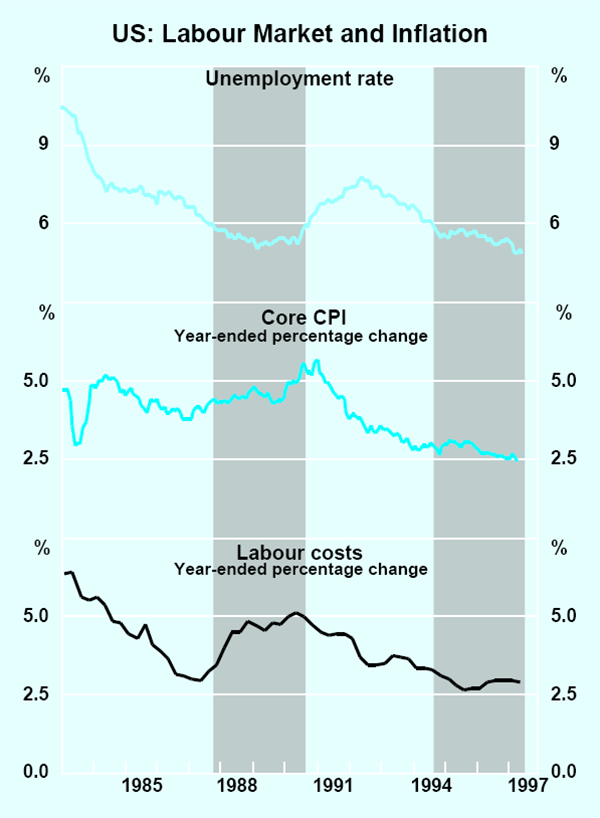
This experience over the past 3 years stands in contrast to earlier episodes. The unemployment rate last fell below 6 per cent in the late 1980s. Over the subsequent 3 years, core consumer price inflation increased by over 1 per cent rather than trending down as it has in the current cycle. The difference in inflation outcomes in these two cycles has reflected the different behaviour of labour costs. In the late 1980s, growth in labour costs accelerated markedly as the unemployment rate trended down whereas, over the past three years, labour-cost growth has been much more subdued. As a consequence, the monetary policy responses in the two episodes were also quite different. The Federal funds rate was raised to nearly 10 per cent in response to inflationary pressures in the late 1980s, whereas in the current cycle it has remained at or below 6 per cent; currently it is at 5½ per cent.
Asia–Pacific
The strength of the Japanese economic recovery remains difficult to assess. GDP increased by 1.6 per cent in the March quarter, but much of that strength reflected private consumption being brought forward in anticipation of the sales tax rise on 1 April. In the aftermath of this tax rise, consumption indicators have been weak and the unemployment rate in May returned to its post-war peak of 3.5 per cent.
Other indicators suggest that a firmer trend may be emerging. In the business sector, confidence has been improving since 1994. Over the past year, for the first time in five years, more large firms viewed business conditions as favourable than as unfavourable. Small firms, however, remain somewhat more pessimistic. The relative optimism of large firms arises, in part, because of their greater access to export markets relative to small firms. Export growth has been running at its highest rate in a decade, driven largely by the substantial depreciation of the yen since early 1995 (Graph 23).

Prices in Japan remain stable. Core consumer prices rose by 2.0 per cent in the year to June, but the bulk of this reflected the effects of the April tax increases. Reflecting the combination of stable prices and weak demand, the short-term policy interest rate remains at its historically low level of ½ per cent.
In other east Asian economies, industrial production and trade growth began to recover in early 1997 following a much weaker period over the previous year (Graph 24). To what extent this recovery will be delayed by the effects of recent financial developments remains to be seen. Confidence in the region may have been adversely affected, at least temporarily, by the sharp movements in currencies and interest rates that followed the attack on the Thai baht. Moreover, in a number of countries in the region, the high interest rates needed to defend currencies may aggravate their domestic problems of financial fragility. This situation suggests there is some near-term risk to the prospect of a rapid recovery in east-Asian trade, which would also have consequences for Australia's exports.
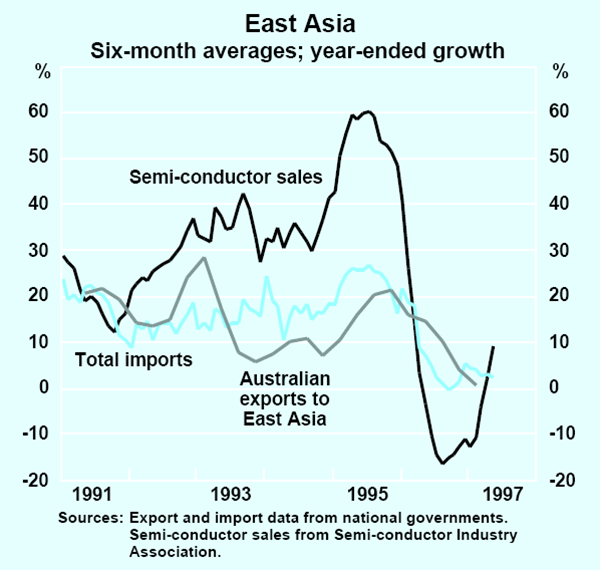
Europe
In Europe there are significant divergences between the three largest economies (Germany, France and Italy) where growth has been rather subdued, and a periphery of faster-growing economies. In Germany, France and Italy, growth has remained insufficient to prevent an upward drift in unemployment rates to post-war highs in each country. Domestic price pressures are absent, with inflation under 2 per cent in all three countries. There are signs that growth is picking up in this continental core of countries, driven primarily by external demand which has been helped by weakening exchange rates, and a result in part of accommodating monetary policy. The signs of quickening growth are clearest in France and Germany; in Italy, output contracted slightly over the year to the March quarter 1997, although signs of recovery are now emerging. For each of these economies, however, it is anticipated that the pick-up in growth will be gradual.
Forming a periphery around this continental core of countries, a considerable number of European economies (of which the United Kingdom is the largest) have been growing quite strongly for several years. The economic output of these countries, taken together, is roughly the same as France and Italy combined, so their economic fortunes have an important bearing on Europe as a whole. In all of the countries that make up this periphery, unemployment has fallen over the past few years, although in some cases from a very high level (unemployment remains over 20 per cent in Spain and over 10 per cent in Ireland and Finland). While inflation remains well-contained in all of these economies, price pressures are emerging in some of them, leading authorities to raise interest rates. OECD forecasts suggest that, in aggregate, these economies will continue over the next couple of years to grow more rapidly than the major continental European economies.
Commodity prices
Commodity prices have declined since April, following firm rises in the March quarter. The fall has been concentrated in the rural sector, where prices have fallen by almost 8 per cent over the past couple of months. This fall mainly reflects lower wheat prices, which are down by around 20 per cent since April, due to expectations of a large US wheat harvest. Stronger wool prices, driven by increased demand from Europe and China, have offset this weakness to some extent.
Non-rural prices have softened a little in recent months, mainly due to lower gold prices. Gold prices declined by almost 6 per cent in the June quarter and by around 15 per cent during 1996/97. Other non-rural commodities prices have been fairly stable since March. Base metal prices have consolidated their position after rising strongly in the March quarter, and now stand about 15 per cent higher than a year ago. This strength is consistent with solid growth in the United States and generally improving conditions in Europe and Japan. Oil prices have now stabilised at around US$20 a barrel, which is about their average level over the past five years.
Financial Market Developments
Financial markets across all industrial countries, including Australia, remained very bullish in the June quarter, with bond yields falling and equity prices rising. While there were some country-specific factors at work, the underlying cause was the universal absence of inflationary pressures across the developed world, encouraging confidence that the current low structure of short-term interest rates, a feature of global markets in the 1990s, can be sustained.
Markets gained confidence from the ability so far of the US economy to operate at levels close to capacity without causing inflationary pressures. In this environment, there has been debate about whether, as a result of the advances in information technology, the world economy has entered a new phase characterised by an enhanced capacity for non-inflationary growth. This debate, of course, remains unresolved, but for the moment market participants seem prepared to bet that a new growth paradigm is a good possibility.
At this stage, it is difficult to know whether the sharp increases in market valuations over the past couple of years are soundly based, or simply the building of a speculative bubble. What is clear, however, is that markets require a continuation of good news on inflation, economic growth and profits to sustain current valuations.
In Australia, the falls in bond yields have been larger than elsewhere, as the wage pressures of 1996, which had been a cause of uncertainty in markets, have lessened. On the other hand, the Australian share market does not appear to have reached the high valuations evident in some other countries. The Bank's overall assessment of domestic financial developments was that they did not stand in the way of further easings of monetary policy.
In contrast to developments in industrial countries, emerging markets, particularly those in south east Asia, have been subject to a good deal of turbulence in recent months, with intense exchange rate pressures in a number of them. This follows some slowing in these economies after a prolonged period of very strong economic growth, which in some cases had produced a number of economic and financial imbalances.
Interest rates
For the reasons outlined earlier, the process of easing monetary policy in Australia, which was initiated in July 1996, continued in recent months. The Bank announced two further cuts of half a percentage point in the target cash rate, on 23 May and 30 July, taking this target to 5.0 per cent. This is only marginally above the low point for the cash rate of 4.75 per cent in 1993/94.
The May easing had not been anticipated by markets, and therefore had not been priced into various interest rates. As such, security yields fell by about 0.5 of a percentage point on the announcement, to levels consistent with the new cash rate target. In contrast, the July easing was fully anticipated (Graph 25). In fact, short-term security yields had begun to incorporate a monetary easing by early June. These expectations grew following weak employment figures and, later, the good inflation and wages results for the June quarter. By the time the easing was announced, the yield on 90-day bank bills had fallen to slightly over 5 per cent, and there was little further movement on the announcement.
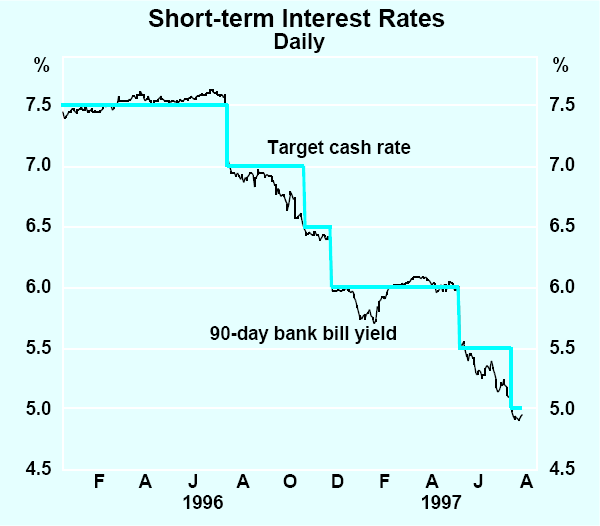
These reductions in short-term interest rates resulted in a corresponding fall in the cost of banks' wholesale funding. On retail deposits, however, the current historically low structure of interest rates meant that banks' discretion to reduce rates was more limited. About a third of bank funding comes from retail deposits. The level of interest rates on many small transaction/statement accounts had already fallen to less than 1 per cent before May, implying that only a small part of any subsequent cuts in the cash rate could be reflected in these deposit rates; rates on transaction/savings accounts were reduced to 0.15 per cent in May. Rates paid on so-called ‘deeming’ accounts, offered to retired individuals and some social security recipients, are equivalent to the deeming rate set by the Department of Social Security for taxation purposes. This rate is currently set at 6 per cent for large balances, around a percentage point higher than money market rates paid by banks. With such a competitive interest rate, these accounts have attracted large inflows over the past year or so, and have held up banks' overall cost of funds.
All up, taking reductions in retail and wholesale funding costs into account, the Bank estimates that the cost of bank deposits fell by about 70 basis points as a result of the May and July easings, somewhat less than the combined fall in the cash rate. Such differences are not unusual; Graph 26 shows that the cash rate typically rises by more than banks' costs of funds when monetary policy is tightened, and falls by more when policy is eased, because banks raise some of their funds through no-interest deposits or deposits whose interest rates do not vary pari passu with cash rates. In contrast, the cost of funds of banks' competitors, such as mortgage managers who fund themselves entirely in wholesale markets, tends to fall in line with the cash rate.
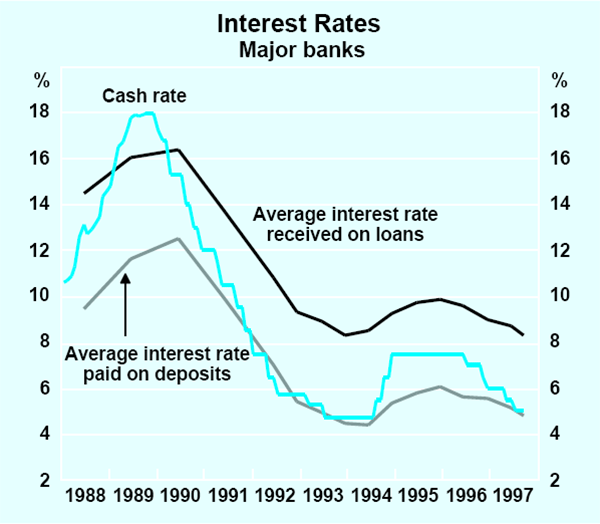
In a fully competitive market, it might be expected that banks would be forced to lower their lending rates by the full extent of the fall in the cash rate, squeezing their average margins. However, in response to the May easing, most banks announced reductions on standard variable loans by amounts roughly in line with the reduction in their overall cost of funds – i.e. less than the full cut in the cash rate.
This reflected the dynamics of the housing loan market at the time. Over the previous year, banks had been gaining market share from mortgage managers because they had substantially cut their interest rates on housing loans. In June 1996, and again in February 1997, banks cut the rate on standard variable housing loans by about 0.75 of a percentage point independently of any change in monetary policy. As such, over the year to May 1997, interest rates on standard housing loans of banks had fallen by substantially more than the cash rate, to levels similar to those charged by mortgage managers. Consequently, banks began to recover the market share lost to mortgage managers in the preceding few years. Against this background, after the easing in May, banks were under less pressure to match fully the cuts announced by mortgage managers.
Subsequent figures have shown, however, that as a result of this and the adverse publicity that banks received, mortgage managers' share of new housing lending has increased sharply. Banks made a fuller response to the July easing, although again some did not pass on all of the cut in the cash rate. The predominant standard variable housing rate from banks is now 6.7 per cent, 0.3 of a percentage point higher than the rate charged by mortgage managers.
Banks and other intermediaries these days offer a range of facilities for housing lending, and changes in rates charged on these other facilities have varied. Reductions in banks' ‘honeymoon’ rates ranged from no change at all to the full reduction in cash rates. The average ‘honeymoon’ rate is 6.0 per cent, compared with 6.75 per cent at the beginning of May, although some rates are as low as 4.99 per cent. Interest rates on housing loans fixed for periods of three and five years, funding costs of which are determined in relevant swaps markets rather than by the cash rate, have fallen by around 100 basis points since early May. These rates now average 7.3 and 7.8 per cent, respectively.
Notwithstanding the partial passing on to housing rates of the recent cuts in the cash rate, the overall effect of all the reductions over the past year or so is that the structure of bank housing interest rates is as low as it has been since 1970 (Graph 27). The predominant rate is now 2 percentage points lower than in 1993, even though the cash rate is still a little above the cyclical low reached at that time. Competition in the housing loan market in Australia has produced spreads against funding costs which are slim by historical standards, and in line with those in other comparable countries.

In the case of large business loans, banks' responses to the two easings involved a reduction on average of 85 basis points, taking the benchmark rate to around 8.5 per cent. Rates on loans to small businesses were generally lowered by the full percentage point reduction in the cash rate, with the typical indicator rate currently at 8.75 per cent. Further signs of growing competition for small business lending appeared in late July, when a mortgage manager announced a loan product for small businesses at a rate about 1 percentage point below banks' indicator rates at that time. As with housing rates, these moves have taken the structure of business lending rates below the level of 1993, then the lowest structure of business rates for two decades.
The latest cuts in banks' lending rates became effective with similar lags to those announced with the easings through the second half of 1996. These lags were longer than those associated with the increases in lending rates that followed the tightening of policy in 1994 (Table 7). For example, the average lag in lowering the interest rate on standard housing loans in May and July was about 7–8 weeks, compared with a lag of 2–3 weeks when banks raised rates in 1994.
| Easings 1990–93 | Tightenings 1994 | Easings 1996–97 | |
|---|---|---|---|
| Housing indicator rate | 32 | 16 | 51 |
| Large business indicator rate | 18 | 16 | 21 |
| Small business indicator rate | 23 | 16 | 35 |
Long-term interest rates in capital markets have also continued the downward trend evident over the past year (Graph 28). A range of international and domestic factors worked, in concert, to reduce bond yields in Australia. Internationally, continuing good news on inflation saw expectations of further tightening in the United States pushed back. The yield on 10-year US Treasuries fell to 6.0 per cent, about 75 basis points below the yield prevailing when the Fed tightened last March. Bond yields in Germany and Japan also fell.
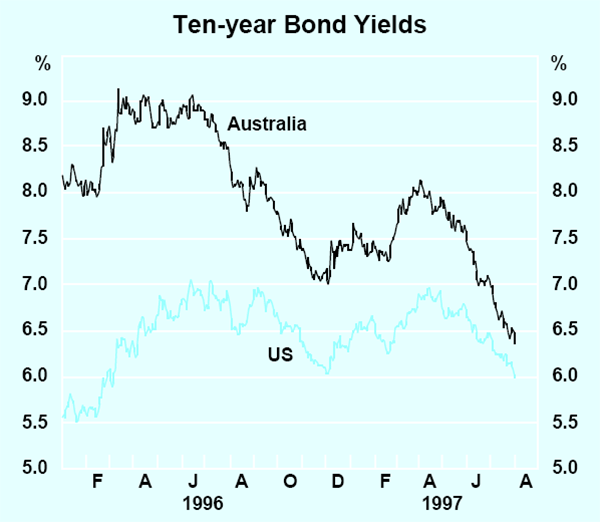
Bond yields across all industrial countries are at low levels at present. The highest yields are in the UK, where economic activity has been very strong and the Bank of England has tightened monetary policy. Even there, however, yields, at 7 per cent, are not high by historical standards.
As well as confidence in the inflation outlook, worldwide efforts to impose greater fiscal restraint have encouraged bond yields to fall. For the OECD countries as a group, announced plans for fiscal consolidation would see budget deficits in 1998 of about 1.7 per cent of GDP, the lowest since the late 1980s, and only about half the average of the early 1990s. Although these planned reductions in deficits are modest – and, in some cases, yet to be delivered – markets have responded positively.
Australia has been part of this international trend of fiscal consolidation. The Commonwealth's 1997/98 budget delivered in mid May reaffirmed the Government's commitment to raising national saving by moving the budget to underlying surplus in coming years. Partly reflecting this, Moody's announced that Australia's credit rating would be placed on a ‘positive watch’.
By late July, this mix of benevolent influences saw the yield on 10-year bonds returning to about 6.4 per cent, equal to the previous cyclical low of January 1994, and its lowest level for a quarter of a century. While the progressive fall in bond yields over the past couple of years reflects international tail winds and better fiscal settings, fundamentally it has been underpinned by the steady improvement in domestic inflation expectations. The drop brings bond yields in Australia to a position more in line with those in comparable countries, after the disproportionate rise in the bear market of 1994.
Interest differentials
As a result of the larger fall in short-term interest rates and bond yields in Australia than abroad, both short-term and long-term interest differentials have narrowed (Table 8). They have traditionally favoured Australian dollar investments, but short-term interest rates in Australia are now below those in the United States, the United Kingdom and New Zealand.
| Australia less | 31 July | June 1996 | Nov 1994 |
|---|---|---|---|
| Long-term | |||
| United States | 35 | 200 | 250 |
| Germany | 85 | 225 | 310 |
| Japan | 400 | 570 | 575 |
| Canada | 55 | 115 | 130 |
| New Zealand | −30 | 20 | 150 |
| United Kingdom | −50 | 100 | 200 |
| Short-term | |||
| United States | −60 | 210 | 150 |
| Germany | 180 | 425 | 220 |
| Japan | 425 | 695 | 510 |
| Canada | 130 | 280 | 150 |
| New Zealand | −330 | −265 | −170 |
| United Kingdom | −215 | 190 | 155 |
The differential between 10-year bond yields in the United States and Australia fell to around 35 basis points, below the spread at the low-point in Australian bond yields in January 1994, and the lowest level since August 1984. The current slim spread, however, signifies a much healthier state of affairs than the situation of the mid 1980s: in 1984, bond yields both in the United States and Australia were around 13–14 per cent, with US yields having increased as US inflation expectations deteriorated; the recent experience has seen bond yields in Australia fall toward those in the United States, based on comparably low inflation rates. Differentials between Australia and a number of other countries have also fallen. Since the global peak in bond yields in 1994, the 10-year yield in Australia has fallen by an average of about 2 percentage points relative to those abroad.
The yield curve in Australia for securities with a maturity of less than five years has moved below that segment of the yield curve in the United States (Graph 29). For longer maturities, the yield curve in Australia remains slightly higher than in the United States. The short end of the yield curve is heavily influenced by the stance of monetary policy and, accordingly, the relative position of short-term interest rates reflects the cyclical position of the two economies at present, with Australia in a weaker phase than the United States. The long end of the curve is determined by the market's expectations about economic performance and inflation likely to be achieved over the longer haul. The narrow differential between long-term bond yields in Australia and in the United States suggests confidence that Australia will sustain the recent performance on inflation beyond the medium term. The experience of 1994 suggests, however, that such confidence might prove fragile if there were much slippage on the inflation front, or if world bond market conditions in general were to deteriorate.

Equity prices
Equity prices continue to set new records in many countries (Graph 30). On Wall St, the Dow Jones index has pushed well above the 8,000 level – with a rise of 28 per cent so far in 1997. The benign outlook for interest rates and confidence in the economic outlook, with expectations of strong corporate earnings, have been the foundation of this strength. European share markets have also been rising strongly, with market indices in London rising by more than 20 per cent and in Frankfurt by 50 per cent so far in 1997. The notable strength in Frankfurt reflects the restructuring that is being undertaken by German companies, reinforced by the depreciation of the mark in recent months, both of which are expected to boost profitability in Germany. After rising strongly in April, the Nikkei Index in Japan had moved by end-July to around the 20,000 level.
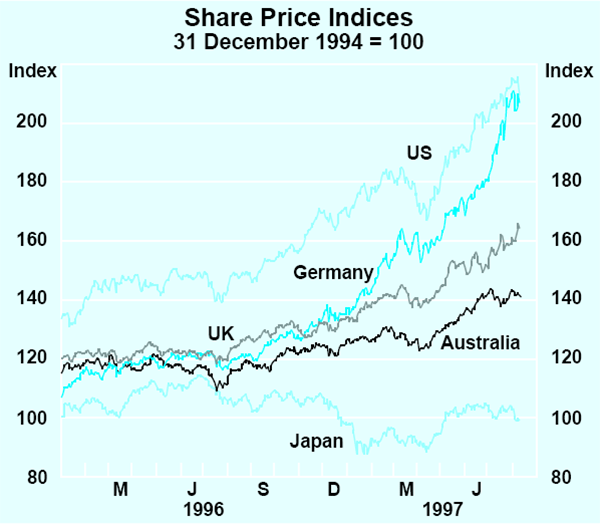
One factor which has seemed to boost equity markets in recent months, and has also been evident in bond markets, is that investors seem to have re-rated long-term investments to take account of prospective maintenance of low inflation and the prospect of stable economic growth. This climate of stability, as well as providing confidence in the likely persistence of low short-term interest rates, also considerably reduces the risk of marked fluctuations in corporate profitability. The painful process of restructuring businesses, with the aim of raising productivity and cutting costs, has also bolstered optimism about the corporate sector worldwide.
After a period in which share prices in Australia had earlier lagged overseas performance, the All Ordinaries Index has generally kept pace with rises abroad in recent months, and has reached new highs. The All Ords rose by around 10 per cent over the three months to end July – an increase below that in the United States but consistent with price movements in other major markets. Prices of resource stocks recently held back the rise in the overall index with some softening in commodity prices generally. The weakness in the resources sector was more widely based than in gold stocks, prices of which have been falling for much of the past year.
Foreign exchange
The exchange rate of the Australian dollar has declined from the peak levels recorded in the March quarter, both in trade-weighted ted terms and, more noticeably, against the strong US dollar (Graph 31). This fall mainly reflected the fact that foreign investors began to focus early in the June quarter on the possibility of further cuts in Australian interest rates, which would take them to a level comparable with those in the United States – or perhaps lower if the US continued to tighten policy, as was expected at that time. This saw the Australian dollar move lower both ahead of, and after, the May easing. These pressures continued into June and July as expectations grew of another easing. There was, however, some recovery in late July on good trade data which, among other things, refocussed attention on the possibility of a credit upgrade. This provided a good platform for the July easing of monetary policy, the announcement of which had little impact on the exchange rate, no doubt reflecting the fact that it had been largely anticipated. Overall, the Australian dollar has fallen by around 5 per cent against the US dollar since early May, and about 7 per cent since the peak in March.
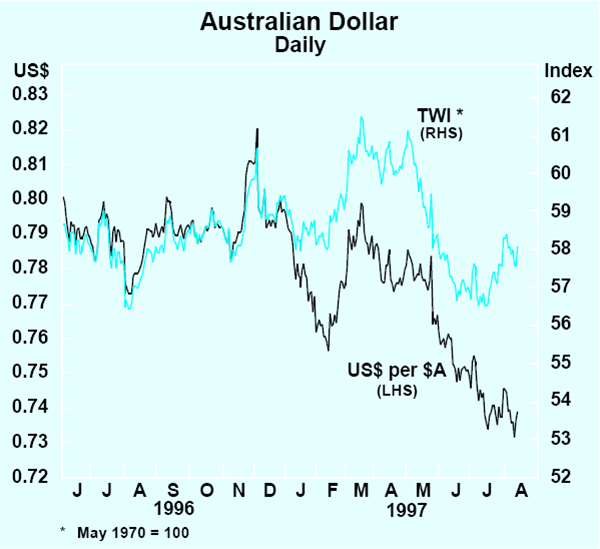
In trade-weighted terms, the Australian dollar has been a little steadier, with recent levels of the TWI down 5 per cent on early 1997 peaks, but close to its average for much of 1996. This reflects the weakening in the exchange rate of a number of Australia's Asian trading partners (see below). The New Zealand dollar and European currencies have also been softer than the Australian dollar, thereby helping to moderate the fall in the trade-weighted index. In the former case, the weakness reflects some softening in the New Zealand economy and a return of inflation into the target range, both of which have led to expectations of an easing in monetary conditions. In the case of European currencies, the weakness reflects a growing view in markets that European Monetary Union will go ahead, and that the new currency, the Euro, will be ‘softer’ than the German mark has tended to be. European currencies have fallen by about 18 per cent against the US dollar so far in 1997.
In the past two months, there have been large falls in the currencies of a number of Asian countries which had been operating systems of pegged or closely managed exchange rates. Similar events have occurred in some emerging countries in Eastern Europe, particularly the Czech Republic and Poland.
These problems followed a period of very rapid economic growth in the first half of the 1990s, in many cases financed to a large degree by strong capital inflows from abroad. In some cases, capital inflows were much larger than desirable, as foreigners tried to get in on the ‘Asian growth miracle’. Exchange rates were held broadly steady through this period, and the strong inflows reflected in a rapid accumulation of foreign exchange reserves. For example, among south east Asian countries, reserves rose by about US$180 billion, to US$350 billion, between 1990 and 1997. At the same time, strong growth led to a number of imbalances in some economies, including large current account deficits and overvalued asset prices.
The capital flows also led to the development of large foreign currency markets in several of the Asian currencies, particularly in the Thai baht. When sentiment turned negative, the existence of large markets made it possible for speculators to borrow very large sums of the currencies concerned for selling in the spot market.
The main focus of market attention has been Thailand. Pressure on the Thai baht first emerged in mid 1996 and again in February 1997. In both episodes, the pressure was met with temporarily increased interest rates. The third wave of capital outflow hit the currency in May, which again prompted higher interest rates, augmented by currency intervention – the Bank of Thailand bought baht in exchange for US dollars – and then imposition of capital controls aimed at preventing further speculative selling of the currency. These measures caused the baht to appreciate by about 10 per cent in offshore markets between mid May and mid June, as speculators attempted to cover short positions. However, they proved unsustainable when further heavy speculation hit the baht after the Philippines widened the trading band for the peso in early July. The Thai authorities floated the baht on 2 July. By mid July, it had depreciated about 20 per cent from its pre-float levels. It subsequently steadied, assisted by the announcement on 5 August of economic reform measures designed to give Thailand access to an IMF co-ordinated assistance package.
Until May, the bouts of pressure on the Thai baht had not been accompanied by pressure on the other Asian currencies. In May, however, there was a quick ‘contagious’ flow-on to the Malaysian ringgit and the Indonesian rupiah, and a little later to the Philippines peso. These countries have contained these pressures by permitting more flexibility in their currencies over the past month or so.
There was also a small fall in the Singapore dollar, although Singapore shared few characteristics with the other economies involved in this. There has also been some modest pressure during July on the Korean won and on the Hong Kong dollar, but net movements in both currencies have been negligible.
The precise reasons for this ‘contagion’ are hard to pinpoint. At least in part, however, it seems to reflect the fact that foreign investors are not well-informed of developments in individual countries, and tend to regard ‘emerging markets’ as one homogeneous group; thus, problems in one country quickly lead to selling of investments in all in the group. This would explain why European emerging markets were affected similarly and at the same time.